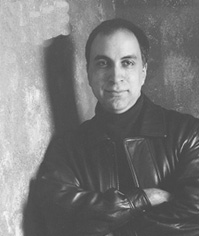
Composer Anthony Cornicello (born in Brooklyn, New York, 1964) writes music that blurs distinctions between performers and electronics, timbre and harmony, composition and improvisation, and explores the boundaries of what may be considered post-classical concert music. His music is vibrant and visceral, full of rhythmic energy and harmonic sophistication, and his forays into live electronics have led to exciting combinations of instruments and processed sound. Cornicello’s background as a jazz pianist is evident not only in the rhythmic activity of his music, but also in his constant investigation of the rich sonorities available from a variety of instruments.
He has been commissioned to write music for the Scorchio Electric String Quartet, ModernWorks! (funding from Meet the Composer/ Commissioning Music USA), the Auros Group for New Music, the Prism Saxophone Quartet, the New York New Music Ensemble, David Holzman, the Group for Contemporary Music, and the InterEnsemble of Padova, Italy. His work has also been featured on the Guggenheim Museum’s “Works and Process” series. Cornicello’s works have also been performed by the Chicago Civic Symphony, Parnassus, ALEA III, Composers Concordance, Madeleine Shapiro, Robert Black, among many other outstanding groups and solo performers. His music has been presented as part of the Darmstadt International Festival of New Music as well as the June in Buffalo Festival.
Cornicello’s Second String Quartet has been recorded by the Atlantic String Quartet; the Second Sonata for Piano by David Holzman (Centaur). More recently, his Post-Modern Waltz was recorded by Eric Moe for Albany Records. A portrait CD of Cornicello’s works is scheduled for 2006 release on Albany Records.
As a performer, he has conducted or played piano in his own works on numerous occasions. While a graduate student at Rutgers, he formed and directed the Janus Ensemble, a group dedicated to contemporary music. More recently, Cornicello has begun performing on the laptop, using a variety of interfaces and the Max/MSP program. Those performances, mostly with EEE!, have had a notable impact on his music, as EEE!’s music ranges from hip-hop to experimental noise. EEE! is based at Eastern Connecticut State University, where Cornicello is an Associate Professor and Director of the Electronic Music Lab.
Cornicello received the Ph.D. from Brandeis University, where he studied with David Rakowski, Eric Chasalow, and Martin Boykan. His teachers also include Charles Wuorinen, Gérard Grisey, and Richard Beirach.
His current fields of interest include developing unusual interfaces for live computer music performances, as well as continuing to investigate resonance and spatialization. His recent and current projects (mostly for string instruments and electronics) have been exploring the latter two, and the series of experimental works ReZenant Garden, performed by EEE! have operated on all three areas of interest. Future projects will include works for instrumental groups or soloists and electronics, as well as turntablists.
Cornicello's works are published by C.F. Peters Corporation and APNM, and he is a member of BMI.
|
|
|
|
|
|

Friday, June 06, 2008
So I played with THroNG
Yes, that's the way it's supposed to be written.
Throng is the product of about 20 years of work by my good friend Mike Rosenstark. Throng is an electronic performance group; it's quite like a rock/jazz group in its basic instrumentation, but the music is not really limited by style. When I sat in last week, it was more like acid/techno/jazz - at least from what I heard. From what you'll see below, the group can sound different on the same tune, depending on your perspective.
So here's the setup: there's Mike on guitar, Chris Dragotta on an EWI controller, his brother Pete on a similar trumpet contoller, Patriq Tappe on guitar, and Kevin Brown on bass; all the musicians also play a synthesizer of some sort. Normally, Ken Lampl plays keyboards, but I filled in for him on last week's session. Everyone is hooked up to a variety of effects units, but most players are running through an AdrenaLinn and a Kaoss 3. The Kaoss Pad is amazing, as there is an X-Y touch pad that controls various aspects of your effect. Everything that can be controlled via MIDI is connected, and at times, one player can control another player's rig.
Alongside all of this is a two-way headphone system. Players can communicate with each other while the music is playing. Although this signal comes through the headphone system, it doesn't become part of the music. This comes in handy, since most of Throng's music is freely improvised.
Now, here's where it gets really interesting. When the band is playing, we deliberately don't hear everyone. Before you say "John Cage and David Tudor did that in 1956!", hear me out. Mike has this system of "Limited Feedback Interaction" that allows some players to hear each other. So, when I was playing, I heard the bass and one of the guitars. The Sax player might have heard the bass and the other guitar, while guitar player #1 heard me and the trumpet. And so on. There is some interaction, but you don't hear the whole band. The music is recorded on six separate tracks (there's another for the whole band mixed together, and the submixes[what we each heard as we played] are also recorded), and the whole thing is uploaded to a website. There's a special player (designed by Dan Rosenstark, Mike's brother) on the site that allows you to play back and re-mix the music.
I'm always surprised at how cohesive the whole thing sounds. Hear it for yourself on the Throng Website.
posted by Anthony Cornicello
|
| |



